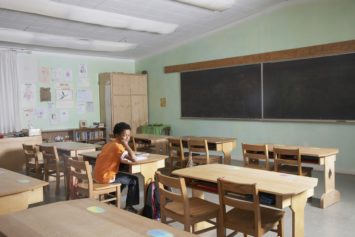
School Dress Codes Become ‘Tool of Oppression’ Against Black Girls Photo credit: David Schaffe/Getty
Imagine this scenario: Your daughter plans to wear a traditional African outfit to school to celebrate Black History Month. Her planned ensemble includes an African dress and a traditional headwrap called a “gele.” On the first day of February, she wears the outfit to school. When she comes home, you might expect her to say that she was complimented on her style or praised for her pride. You would not expect her to say that she was nearly suspended for wearing the outfit.
While the above scenario may seem far-fetched, it happened in Durham, North Carolina, in February 2016. Three African-American girls were reprimanded when school officials demanded that they remove their geles. Why? Because the headscarves violated the school’s dress code.
Sadly, what happened in Durham is common. While the students in that incident were not suspended, new research from the National Women’s Law Center found that dress code violations are not only common but that Black girls were 20 times more likely than white girls to be suspended for dress code violations in Washington, D.C., public schools.
Because nearly every school in America has a dress code of some sort, it is critical that parents — especially Black parents — understand their families’ rights and responsibilities.
Dress codes are not inherently bad. Schools use dress codes to ensure that the learning environment is not disrupted. For this reason, clothing that displays sexually explicit photos or messages can be banned, as well as clothing that advocates crime or contains hate speech. When used properly, dress codes can help a school function smoothly.
Despite good intentions, dress codes nevertheless have negative impacts on Black girls for two reasons. First, they may have difficulty adhering to dress code rules for reasons beyond their control. Second, even where rules appear even-handed, they are regularly enforced against Black female students more often and more harshly.
The NWLC conducted a study that examined the experiences of African-American girls by conducting interviews with 21 students in Washington, D.C., schools and examining the dress codes at their schools.
The NWLC found that over 85 percent of the schools required uniforms. While these rules may seem simple enough, many of the students interviewed for the study reported that the uniforms were too expensive. One student reported that each shirt cost $20, while a single sweater cost $25. Another stated that her uniform cost $300. The NLWC stated that many parents struggle to purchase multiple uniforms.
For schools without uniforms (or uniform schools that allowed “dress down” or casual days), the rules proved more problematic. For instance, the NWLC study found that the schools forbid summer wear even during summer. Conversely, students were not permitted to wear coats, jackets, or non-uniform sweaters in the winter, even when the school buildings were cold.
Even when the rules appeared to be fair, the NWLC study found that the rules were not evenly enforced. It discovered that Washington schools were 20.8 times more likely to suspend Black girls than white girls.
Though the NWLC study is the most recent, it is not the first to reach these conclusions. Dr. Edward Morris of the University of Kentucky has been studying race, gender, and student discipline since 2005. In a study published last year, he examined the frequency and severity of discipline for school infractions in middle and high schools across the state of Kentucky. Dress code violations were included in the lowest category of severity.
While Dr. Morris’ study found that Black boys were twice as likely as white boys to be sent to the office for any infraction, Black girls were referred for punishment three times more often than white girls. The study found that Black girls were three times more likely to be sent to the office for minor transgressions such as violating the dress code.
There are basic reasons why Black girls are more likely to be punished for dress code violations.
First, at times, following a dress code may not be financially possible. In her book “Pushout: The Criminalization of Black Girls in Schools,” Dr. Monique Morris wrote that many of the children that she interviewed for her chapter on dress codes were out of compliance for minor things such as missing a belt or having the wrong color shoes. For most, she wrote, “the shoes they wore were the only shoes in their closet, and the absence of a belt was an oversight.” While not all Black children live in poverty, 61 percent live in low-income families, and of those, 17 percent live in deep poverty. As such, Black families are more likely that many others to struggle to afford uniform supplies.
Because natural hairstyles are popular, they are common among young Black girls. However, hair may subject a Black girl to school discipline. Most dress codes include provisions on acceptable hairstyles — usually, a generic provision that says hair must be kept “clean” or “neat.” Despite the fact that most natural hairstyles are clean and neat, Black girls from across the nation have been disciplined for wearing their hair in dreadlocks, braids, afro puffs, and other natural styles. One school district actually used its dress code policy to specifically ban dreadlocks, cornrows, and twists. Banning these styles opens the door to punishing those most likely to wear them — young Black girls.
Black girls also are disciplined when they do not conform to what society considers feminine.
Dr. Monique Morris wrote that school dress codes “often reflect society’s biases about Black femininity — and Black feminine bodies in particular.” The interviews she conducted indicate that young Black girls are well aware of the different standards applied to their bodies and clothing. One explained, “I feel like there’s a distinction between what Black and other race girls can wear. Not only because of their body shape, because most of the time, Black girls’ bodies are built . . . like, we’re a little thicker, if you know what I mean – in all the right places. Your bottom, your boobs. So, people — like the adults at my school — will say, ‘You’re Black. You can’t wear those because you’re showing much more skin because your body weight and your body shape is different.'”
Some may think that dress code violations are not a big deal. After all, the student has a brief interaction with a teacher, is sent to the office, and then is made to change clothes. No harm, no foul, some would argue. However, the data show that these dress codes, far from causing no harm, can be significantly disruptive events for Black girls.
The NWLC study found that even when Black girls are not suspended, they are often sent home from school when they fail to comply with dress codes. Being sent home from school interrupts a child’s education and deprives them of the ability to complete important assignments, quizzes, or tests that may be assigned in their absence. As the NWLC found, “Both formal and informal classroom removals cause girls to lose out on the opportunity to learn.”
While not all girls are suspended, some are. Suspensions are a serious matter. As the NWLC said, “Suspensions put students at risk for not graduating and going to college.” Moreover, Vox has reported that dress codes are often used to force Black girls onto the school-to-prison pipeline. The serious consequences of suspensions highlight the gravity of this seemingly trivial issue.
Finally, there are intangible consequences to being charged with dress code violations. The NWLC writes that “discriminatory dress codes and unfair enforcement change how Black girls see themselves and how their classmates see them, too.” After repeatedly being punished for minor dress code infractions, many girls simply give up. Dr. Monique Morris wrote that the girls she interviewed “repeated several stories of showing up to school only to be turned away for something minor — like a missing belt or wrong color shoes — rather than a blatant affront to the dress code.” As previously mentioned, often, the clothes the girls wore were the only ones they owned. Also, Dr. Morris reported that many of the Black girls realized or believed that they were unfairly targeted based on their race, gender, or both. After repeatedly experiencing unfair punishment, girls’ positive attitudes toward school may change.
While it is legal for schools to implement dress codes, dress codes that discriminate based on race, gender, or both may violate federal law.
According to the Department of Justice, several laws protect students from discriminatory school discipline. Title IV of the Civil Rights Act of 1964 prohibits race or sex discrimination in public K-12 schools. Title VI of the Civil Rights Act prohibits the same discrimination in programs that receive federal funding, as most public school districts do. Finally, Title IX of the Educational Amendments Act of 1972 forbids sex discrimination in schools that receive federal funding. If a student feels that a dress code has been discriminated against her because she is an African-American female, these laws may provide a remedy. In extreme circumstances, violations may even run afoul of the U.S. Constitution’s equal protection provisions.
According to the American Civil Liberties Union (ACLU), these laws prohibit dress codes that are discriminatory on their face, such as a rule that targets Black hairstyles. Additionally, the ACLU notes that enforcing dress code provisions in a racially biased manner may be illegal. So, while dress codes disproportionately impact Black girls, there is hope.
In a 2016 report, the NWLC found that Black girls were nearly six times more likely to be suspended than white girls. Clearly, as the studies demonstrate, dress codes play a role in creating that discrepancy. As Dr. Monique Morris wrote, “Dress codes, for all of their benefits, have become a tool of oppression.”
In the end, Black girls should have the opportunity to attend school and learn without being punished for who they are or circumstances beyond their control. If schools must punish, it should be for the student’s conduct, not her couture.


